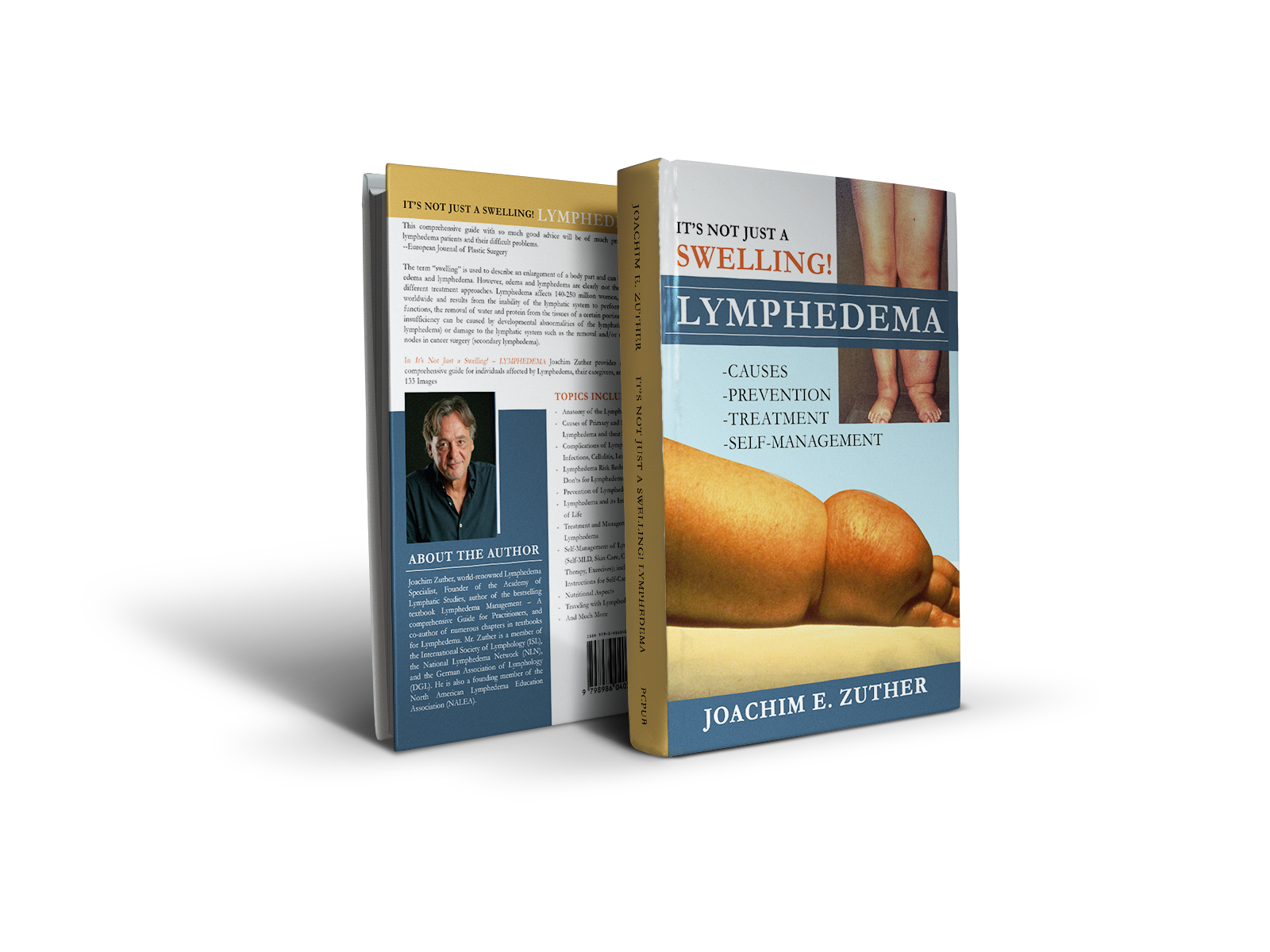New Book for Patients and Caregivers 
In It’s Not Just a Swelling! – LYMPHEDEMA Joachim Zuther provides an up-to-date and comprehensive guide for specifically geared towards individuals affected by Lymphedema, their caregivers, and family members. 133 Images. Paperback and Kindle version
Topics include:
- Self-Management of Lymphedema (Self-MLD, Skin Care, Compression Therapy, Exercises); includes Instructions for Self-Care with images
- Nutritional Aspects
- Lymphedema Risk Reduction, Do’s and Don’ts for Lymphedema
- Complications of Lymphedema, such as Infections, Cellulitis, Leakage
- Lymphedema and its Impact on Quality of Life
- Traveling with Lymphedema
- Prevention of Lymphedema
- Treatment and Management of Lymphedema
- Causes of Primary and Secondary Lymphedema and their Stages
- Anatomy of the Lymphatic System
- And Much More
Click Here to Buy
The Author 
Joachim Zuther, Lymphedema Specialist. Read more |
By Joachim Zuther, on December 4th, 2024
Unlike the heart in the blood circulatory system, the lymphatic system does not have an active pump to propel lymphatic fluid back into the bloodstream. Effective lymph flow depends on sufficient muscle and joint activity, especially if the functionality of the lymphatic system is compromised.
Abdominal (diaphragmatic) breathing exercises are a . . . → Read More: The Benefits of Abdominal Breathing Exercises in the Management of Lymphedema
By Joachim Zuther, on October 28th, 2024
The term “swelling” is used to describe an enlargement of a body part and can be used to describe edema, as well as lymphedema. While the initial causes for the formation of the swelling are different, both involve the accumulation of fluid in the soft tissues of the skin due to some form . . . → Read More: How Lymphatic Insufficiencies Result in Edema or Lymphedema
By Joachim Zuther, on July 15th, 2024
The positive impact a well-tailored regular exercise program can have on a healthy lifestyle, improvement of general well being, increased energy level, and stress and weight management is well known. Additional benefits of exercises for those individuals at risk of, or have lymphedema include improved limb flexibility, range of movement, and most importantly increased . . . → Read More: Why Exercises should be Part of Your Lymphedema Treatment Regimen
By Joachim Zuther, on February 4th, 2024
Unlike the heart in the blood circulatory system, the lymphatic system does not have an active pump to propel lymphatic fluid back to the bloodstream. Effective lymph flow depends on sufficient muscle and joint activity, especially if the functionality of the lymphatic system is compromised. Decongestive exercises are most effective if performed while . . . → Read More: Decongestive and Breathing Exercises for Lymphedema
By Joachim Zuther, on January 1st, 2024
The surgical procedures performed on individuals affected by breast cancer may be mastectomy, partial mastectomy, or lumpectomy. Along with the actual breast surgery for cancer, axillary lymph nodes are removed and/or radiated. As a result of axillary lymph node clearance, the normal lymphatic drainage from the extremity is impaired, and some patients experience the onset . . . → Read More: Lymphedema Risk Reduction
By Joachim Zuther, on November 2nd, 2023
The primary role of compression garments in lymphedema management is to maintain the reduction of the swelling achieved during the intensive treatment phase of Complete Decongestive Therapy (CDT). A high level of consistency in providing the appropriate compression is crucial in order to avoid re-accumulation of evacuated lymphedema fluid. This consistency is provided . . . → Read More: How to Care for Your Compression Garments
By Joachim Zuther, on August 15th, 2023
“After a day of sitting in the office my ankles are swollen.”
“During the last several months of my pregnancy, my legs practically doubled in size”
“My fingers and hand frequently get puffy following a long hike”
“My arm started swelling after I had surgery for my breast cancer”
“Following the removal of . . . → Read More: When is it Lymphedema? Self-Check for Lymphedema
By Joachim Zuther, on July 25th, 2023
Complete decongestive therapy (CDT), sometimes referred to as complex decongestive therapy, or combined physical therapy is the internationally recognized “gold standard” treatment system for the vast majority of patients affected by lymphedema.
Backed by long standing experience, CDT has shown to be safe and effective as the standard therapy for lymphedema. It is . . . → Read More: Complete Decongestive Therapy in the Treatment of Lymphedema
By Joachim Zuther, on May 15th, 2023
Lymphedema is a progressive and chronic condition caused by the disruption or obstruction of normally functioning lymph vessels and/or nodes secondary to surgery involving the lymphatic system, or developmental abnormalities of the lymphatic system itself.
Although the swelling associated with lymphedema can be reduced to a normal or near-normal size by Complete Decongestive . . . → Read More: Nighttime Compression Options for Lymphedema
By Joachim Zuther, on April 17th, 2023
Taking appropriate precautions to reduce the risk of developing lymphedema always makes sense. Traveling in airplanes with pressurized cabins at high altitudes, especially on long-haul flights, may have deleterious effects on unmanaged lymphedema. However, individuals affected by, or at risk for lymphedema should not avoid air travel due to fear. Being aware of . . . → Read More: Lymphedema and Airline Travel
|
Support the Lymphedema Blog This blog is supported by donations. Click to donate today.

Disclaimer The information on this web site is not intended to give medical advice and does not necessarily reflect the opinions of any physicians, nor is it guaranteed to be correct and complete. You should not rely on any information in this web site without seeking the advice of a physician or certified healthcare provider.
|


 Joachim Zuther, Lymphedema Specialist.
Joachim Zuther, Lymphedema Specialist. 
